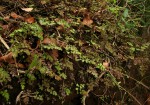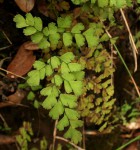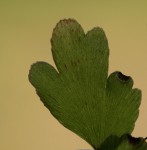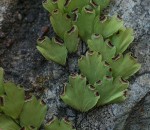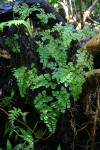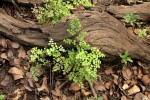Adiantum capillus-veneris
Selected images: Click on each image to see a larger version and details of the record View all images (16)
Detailed records: Display species records QDS maps by: Google Maps Point records by Google Maps
Species details: Click on each item to see an explanation of that item (Note: opens a new window)
| Synonyms: |
Adiantum capillus-veneris L. var. pinnata Bonap. Adiantum coriandrifolium Lam. Adiantum marginatum Schrad. Adiantum paradisea Baker Adiantum pseudocapillus Fée |
| Common names: | Maidenhair fern (English) |
| Frequency: | |
| Status: | Native |
| Description: |
Rhizome creeping, 2-8 mm in diameter; rhizome scales brown, awl-shaped. Fronds closely spaced, herbaceous, glabrous, erect or arching. Stipe up to 25 cm long, thin, wiry, dark brown to black, shining, glabrous. Lamina 2-3 pinnate, pinnate near the apex, triangular to ovate-deltate in outline, 20 × 18 cm. Rhachis and stalks black, shiny, glabrous. Pinnules persistent, 1-2.7 × 0.5-2 cm, wedge-shaped with straight sides, entire to deeply incised on the outer margin into narrow lobes. Lobes with outer margin minutely toothed, veins ending in the marginal serrations. Sori 2-5 beneath pinnule lobes on the undersurface of deflexed, membranous, oblong or slightly curved pale brown, glabrous indusial flaps. |
| Type location: |
|
| Notes: | Can be distinguished from other species (A. poiretii) by having persistent pinnules, oblong or lunulate sori and veins of the pinnules that end in the teeth of the serrations of the outer margins. |
| Derivation of specific name: | capillus-veneris: hair of venus |
| Habitat: | Terrestrial or lithophytic, on moist cliff faces, on boulders and along streams or moist ditches, in low-altitude woodland or medium-altitude riverine forest, exposed or shaded. Very occasional epiphytic on trees in spray of waterfalls. |
| Altitude range: (metres) | Up to 1700 m |
| Worldwide distribution: | Widespread in Africa, with the exception of West Africa. Throughout tropical, sub-tropical and warmer-temperate regions in the rest of the world. |
| FZ divisions: | N,W,C,E,S |
| Growth form(s): | Lithophyte, terrestrial. |
| Endemic status: | |
| Red data list status: | |
| Insects associated with this species: | |
| Spot characters: | Display spot characters for this species |
| Images last updated: | Wednesday 11 July 2012 |
| Literature: |
Burrows, J.E. (1990). Southern African Ferns and Fern Allies. Frandsen, Sandton. Page 123. (Includes a picture). Burrows, J.E. & Burrows, S.M. (1993). An annotated check-list of the pteridophytes of Malawi Kirkia 14(1) Page 86. Chapano, C. & Mamuto, M. (2003). Plants of the Chimanimani District National Herbarium and Botanic Garden, Zimbabwe Page 3. As Adiantum capillusveneris Crouch, N.R., Klopper, R.R., Burrows, J.E. & Burrows, S.M. (2011). Ferns of Southern Africa, A comprehensive guide Struik Nature Pages 430 - 431. (Includes a picture). Da Silva, M.C., Izidine, S. & Amude, A.B. (2004). A preliminary checklist of the vascular plants of Mozambique. Southern African Botanical Diversity Network Report No. 30 Sabonet, Pretoria Page 13. Fischer E. & Lobin W. (2024). Checklist of Lycopodiopsida (clubmosses and quillworts) and Polypodiopsida (ferns) of Rwanda. Willdenowia 53(3) Page 165. Jacobsen, W.B.G. (1983). The Ferns and Fern Allies of Southern Africa. Butterworths, Durban and Pretoria. Pages 228 - 230. (Includes a picture). Kornas, J. (1979). Distribution and ecology of the Pteridophytes in Zambia Polska Akademia Nauk Wydzial II Nauk Biologicznych Page 62. Mapaura, A. & Timberlake, J. (eds) (2004). A checklist of Zimbabwean vascular plants Southern African Botanical Diversity Network Report No. 33 Sabonet, Pretoria and Harare Page 9. Ntore, S. & al. (2024). Checklist of the vascular plants of Burundi Page 34. Roux, J.P. (2001). Conspectus of Southern African Pteridophyta. Southern African Botanical Diversity Network Report 13 Page 74. Roux, J.P. (2009). Synopsis of the Lycopodiophyta and Pteridophyta of Africa, Madagascar and neighbouring islands Pages 68 - 69. Schelpe, E.A.C.L.E. (1970). Pteridophyta Flora Zambesiaca Page 112. (Includes a picture). Setshogo, M.P. (2005). Preliminary checklist of the plants of Botswana. Sabonet Report no. 37. Sabonet, Pretoria and Gaborone Page 15. |
Other sources of information about Adiantum capillus-veneris:
Our websites:
Flora of Botswana: Adiantum capillus-venerisFlora of Burundi: Adiantum capillus-veneris
Flora of the DRC: Adiantum capillus-veneris
Flora of Malawi: Adiantum capillus-veneris
Flora of Mozambique: Adiantum capillus-veneris
Flora of Rwanda: Adiantum capillus-veneris
Flora of Zambia: Adiantum capillus-veneris
External websites:
African Plants: A Photo Guide (Senckenberg): Adiantum capillus-venerisAfrican Plant Database: Adiantum capillus-veneris
BHL (Biodiversity Heritage Library): Adiantum capillus-veneris
EOL (Encyclopedia of Life): Adiantum capillus-veneris
GBIF (Global Biodiversity Information Facility): Adiantum capillus-veneris
Google: Web - Images - Scholar
iNaturalist: Adiantum capillus-veneris
IPNI (International Plant Names Index): Adiantum capillus-veneris
JSTOR Plant Science: Adiantum capillus-veneris
Mansfeld World Database of Agricultural and Horticultural Crops: Adiantum capillus-veneris
Plants of the World Online: Adiantum capillus-veneris
Tropicos: Adiantum capillus-veneris
Wikipedia: Adiantum capillus-veneris
